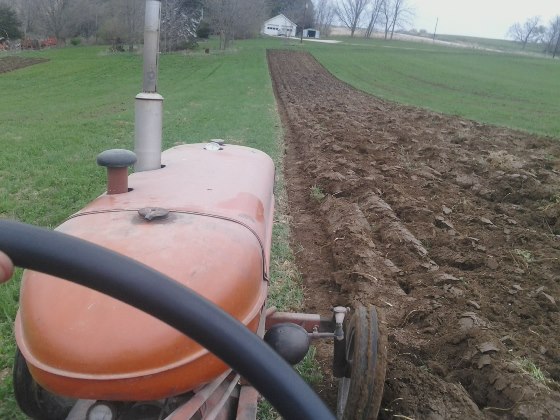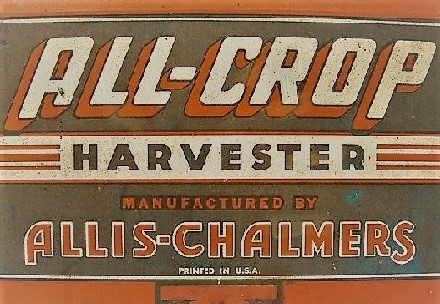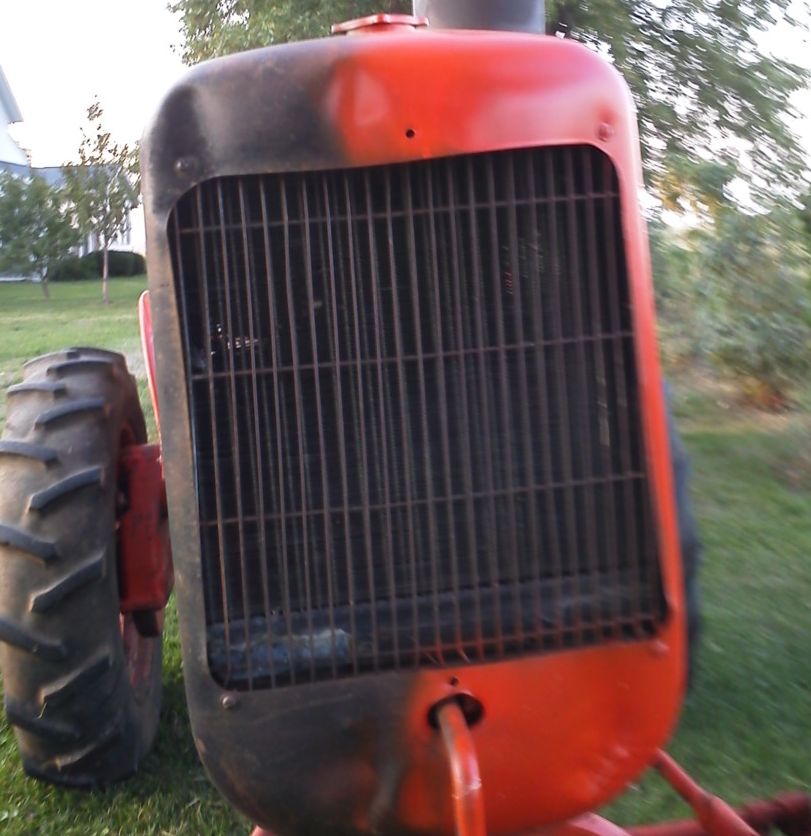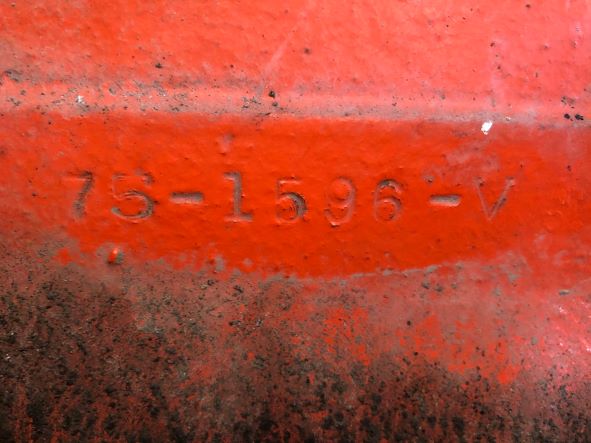| Author |
 Topic Search Topic Search  Topic Options Topic Options
|
CORLEWFARM 
Bronze Level Access

Joined: 25 Jan 2011
Points: 114
|
 Post Options Post Options
 Thanks(0) Thanks(0)
 Quote Quote  Reply Reply
 Posted: 23 Dec 2022 at 8:02am Posted: 23 Dec 2022 at 8:02am |
|
A WD45 was better filling a silo than a G John Deere. Story was told that the Deere kept stopping up the blower and my grandfather brought a D14 from his dealership and the pipe never stopped up. After that they bought a used 45 to run the blower.
|
 |
|
Sponsored Links
|
|
 |
WF owner 
Orange Level

Joined: 12 May 2013
Location: Bombay NY
Points: 4664
|
 Post Options Post Options
 Thanks(0) Thanks(0)
 Quote Quote  Reply Reply
 Posted: 23 Dec 2022 at 12:47pm Posted: 23 Dec 2022 at 12:47pm |
Even the 201 was good on the blower. When Dad bought a 20' x 50' silo, our local AC dealer tried to sell him a new tractor/blower. My grandfather's WF filled it many times with an old AC long trough blower.
Dad told the story that my (maternal) grandfather had his Farmall M on an old Papec ensilage cutter, one very wet year when it was too wet to tow a forage harvester. The M broke a valve (which I understand was a pretty common occurrence when running at prolonged high RPMs). Dad told him to put his WD45 on it. My grandfather told him it would ruin his new tractor. They used the WD45 for the rest of the year. The only problem they had was they sheared the shear pins in the ensilage cutter several times, trying to plug the blower.
|
 |
captaindana 
Orange Level

Joined: 14 Sep 2009
Location: Fort Plain, NY
Points: 2460
|
 Post Options Post Options
 Thanks(0) Thanks(0)
 Quote Quote  Reply Reply
 Posted: 23 Dec 2022 at 12:57pm Posted: 23 Dec 2022 at 12:57pm |
|
I don’t believe there was a ‘snappier’ governor back then that would come close to a ‘45 on the blower or chopper. I was just a little kid then but all the farmers were saying such.
|
|
Blue Skies and Tail Winds
Dana
|
 |
Alex09(WI) 
Orange Level


Joined: 15 Mar 2012
Location: CECIL WI
Points: 1699
|
 Post Options Post Options
 Thanks(0) Thanks(0)
 Quote Quote  Reply Reply
 Posted: 23 Dec 2022 at 9:27pm Posted: 23 Dec 2022 at 9:27pm |
175 gas engine serial #s always end in a -V from what I've seen. Here is one from a repair we did back in May 2020.
|
|
www.awtractor.com
A&W TRACTOR 920-598-1287
KEEPING ALLIS-CHALMERS IN THE FIELDS THROUGH THE 21ST CENTURY
|
 |
DrAllis 
Orange Level Access

Joined: 12 Sep 2009
Points: 20479
|
 Post Options Post Options
 Thanks(1) Thanks(1)
 Quote Quote  Reply Reply
 Posted: 23 Dec 2022 at 9:48pm Posted: 23 Dec 2022 at 9:48pm |
|
Thank you so much, Alex !! So, the AC owners manual AND the Nebraska Test information are indeed incorrect !! A-C designated this last generation G-226 engine (8.25 to 1 compression/ special camshaft grind / Marvel TSX928 carb with 2 inch air inlet and 1 inch venturi) as the "75" - XXXX - V. The D-17 engines were "17" ........ the One-Seventy engines were "7" ....... and the 175 engines were "75" ....... information complete !!! Now, to track down the one and only surviving One-Eighty prototype tractor with the G-226 engine ( I know where it is)....wonder what it says ?? I know it has a mechanical fuel pump on it underneath the engine oil filter. My wild guess is 8 - 1001 - V ?
Edited by DrAllis - 24 Dec 2022 at 6:51am
|
 |
Alex09(WI) 
Orange Level


Joined: 15 Mar 2012
Location: CECIL WI
Points: 1699
|
 Post Options Post Options
 Thanks(0) Thanks(0)
 Quote Quote  Reply Reply
 Posted: 24 Dec 2022 at 10:59am Posted: 24 Dec 2022 at 10:59am |
That G226 powered 180 is the first tractor built by hand that never had vibration problems, correct?
Here is a EIII combine engine that is now in my 170 tractor. The combine engines may have had different serial designations than the tractors? Has a D17 prefix but 170 suffix with 8.0:1 comp ratio?
Normal d17 tractor engine serial # here showing 7.25: comp ratio:
|
|
www.awtractor.com
A&W TRACTOR 920-598-1287
KEEPING ALLIS-CHALMERS IN THE FIELDS THROUGH THE 21ST CENTURY
|
 |
DrAllis 
Orange Level Access

Joined: 12 Sep 2009
Points: 20479
|
 Post Options Post Options
 Thanks(0) Thanks(0)
 Quote Quote  Reply Reply
 Posted: 24 Dec 2022 at 11:30am Posted: 24 Dec 2022 at 11:30am |
|
Correct. D-17 G-226 with M code is 7.25 to 1 compression and Z-code is 8.0 to 1 compression ratio. So, at the time that engine was built, I assume it was before July of 1967 when the One-Seventy was released. Really makes no difference, because the letter determines the compression ratio when that engine was built. The "V" code was in D-17 factory LPgas engines and all 175 gas engines. Yes, the lone non-vibrating One-Eighty G-226 tractor still exists., and as I said it does have a fuel pump on it to keep up to the 5.5 GPH fuel burn rate that 64 HP would require.
|
 |
SteveM C/IL 
Orange Level Access

Joined: 12 Sep 2009
Location: Shelbyville IL
Points: 8236
|
 Post Options Post Options
 Thanks(0) Thanks(0)
 Quote Quote  Reply Reply
 Posted: 24 Dec 2022 at 1:43pm Posted: 24 Dec 2022 at 1:43pm |
|
So I trust this "special" 180 is in good hands. The owner knows what he has and it will be preserved for the ages?
|
 |
DrAllis 
Orange Level Access

Joined: 12 Sep 2009
Points: 20479
|
 Post Options Post Options
 Thanks(1) Thanks(1)
 Quote Quote  Reply Reply
 Posted: 24 Dec 2022 at 3:06pm Posted: 24 Dec 2022 at 3:06pm |
|
They know what it is. How it's cared for, I don't know. I hope to maybe be able to view it again (I saw it in August of 1980 at the test farm south of Milwaukee) and gather some data. I'd like the complete engine serial number ( if it has one), a picture and tag number of the carburetor and a look in thru the bell housing inspection hole to verify the pressure plate mounting bolt size (3/8" or 1/2"). The pressure plate bolt size (to me) would indicate if it was just an 11 inch D-17/170 flywheel/clutch assembly, OR a custom made 12 inch flywheel/clutch like the diesel engine had. Just curious is all, but in my mind I'm convinced it was/is just a 175 gas engine that ran 2,200 RPM to get 64 PTO HP.
Edited by DrAllis - 24 Dec 2022 at 3:16pm
|
 |
JimIA 
Orange Level


Joined: 12 Sep 2009
Location: Castalia Iowa
Points: 1980
|
 Post Options Post Options
 Thanks(0) Thanks(0)
 Quote Quote  Reply Reply
 Posted: 30 Dec 2022 at 9:51pm Posted: 30 Dec 2022 at 9:51pm |
 DrAllis wrote: DrAllis wrote:
The G-226's biggest weakness, was poor oil pressure/dirty oil. Once they went to the "full-flow" oiling system, that engine was the best they had had to date in late 1959. So, the first two years of G-226's were maybe a little suspect. I have seen several over the last 45 yrs that still had the old oiling system on them and they survived. But, I also know of an old customer who had an old D-17 and he claimed he had nothing but trouble with crankshaft/bearings/oil pressure that he finally had to get rid of it, and switched brands. I believe those old original oiling system engines were probably failing in the heavy tillage applications, where engines performing lighter jobs didn't have that much trouble. By the time the series 4 came along (with the nitrided crankshaft journals) that was another step forward. I think the competitive engines you've listed would compare more to the 40 HP class instead of the 50+ HP class. The Ford engines were a good cheap engine, using a cast iron crankshaft versus the A-C forged steel crank and a parent bore block instead of wet-sleeves. The G-226 family was ALWAYS the easy overhaul "wet-sleeve" design, which cost more money to build, but service-wise was the best idea there was. No time consuming block boring. Just knock out the old sleeves and drop in new ones !! If I had an improvements wish list for the G-226, it would have been sodium filled or stellite exhaust valves, a rubber type rear seal and better manifold gaskets. I may have mentioned this before, but I had a classmate in jr high and high school, whose Dad had a series 4 D-17 AND a 2510 John Deere. Both gas engines. Both rated at 53 PTO HP. They did all their plowing and discing with the D-17. The 2510 was 180 cubic inches that ran 2700 RPM high idle. The D-17 was 226 cubes and ran 2,000 RPM. |
Ive always said the only thing I would change about this engine is to have a rubber rear main seal and extend the block past the crankshaft and have a flat flange on the oil pan. The did it with the 125-160 engines, why couldnt they do it with the 226?
|
|
An open eye is much more observant than an open mouth
|
 |
DrAllis 
Orange Level Access

Joined: 12 Sep 2009
Points: 20479
|
 Post Options Post Options
 Thanks(0) Thanks(0)
 Quote Quote  Reply Reply
 Posted: 30 Dec 2022 at 9:59pm Posted: 30 Dec 2022 at 9:59pm |
|
The little B-C-CA engine started out life being the frame of the tractor would be my guess. The W/G series never had to do that because they were used in things that had side frames. Doing that would have added cost to the engine that wasn't needed. Just a guess. But the rear seal could have been 2-piece rubber lip with a wire thru the seal. FoMoCo had rear seals like that.
|
 |
davemel3nzc 
Bronze Level

Joined: 10 Apr 2018
Location: Clarkaville, Mi
Points: 4
|
 Post Options Post Options
 Thanks(0) Thanks(0)
 Quote Quote  Reply Reply
 Posted: 13 Jan 2023 at 8:09pm Posted: 13 Jan 2023 at 8:09pm |
 DrAllis wrote: DrAllis wrote:
As I understand it, a "Z" code means 8.0 to 1 compression ratio, which should be a One-Seventy engine. So, the serial number should be 7- XXXX -Z and that should be 1967 til 1973 ?? A D-17 engine serial number is 17- XXXX -M for a gasoline engine and maybe "V" for an LPGas engine and ran from late 1957 til mid 1967. I think the 175 engine serial number would be 77- XXXX -V from 1973 til early 1976. **** EDIT: I'm a little confused on the 175 gas engines s/n. My 175 owners manual gives reference to 7- XXXX- Z, which cannot be correct, as the compression code should be "V" for 8.25 to 1. Nebraska Test lists the test tractor engine as 77100 with no letter code. So, if someone has a 175 gasser, could you please look at your engine s/n and report back ?? Thanks. |
|
 |
davemel3nzc 
Bronze Level

Joined: 10 Apr 2018
Location: Clarkaville, Mi
Points: 4
|
 Post Options Post Options
 Thanks(0) Thanks(0)
 Quote Quote  Reply Reply
 Posted: 13 Jan 2023 at 8:22pm Posted: 13 Jan 2023 at 8:22pm |
Mine is a 1975 175 Gas. S/N 175 3685 Only 245 made that year. Engine S/N 75-1849-v
Edited by davemel3nzc - 13 Jan 2023 at 8:24pm
|
 |
DrAllis 
Orange Level Access

Joined: 12 Sep 2009
Points: 20479
|
 Post Options Post Options
 Thanks(0) Thanks(0)
 Quote Quote  Reply Reply
 Posted: 13 Jan 2023 at 8:25pm Posted: 13 Jan 2023 at 8:25pm |
|
Thank you for the help and confirmation of the 175 gas engine serial number format. Like I said, Nebraska Test and the AC owners manual didn't have correct information.
|
 |
Tracy Martin TN 
Orange Level Access


Joined: 11 Sep 2009
Location: Gallatin,TN
Points: 10624
|
 Post Options Post Options
 Thanks(0) Thanks(0)
 Quote Quote  Reply Reply
 Posted: 14 Jan 2023 at 11:53am Posted: 14 Jan 2023 at 11:53am |
|
A low hour unmolested 175 gas is my dream tractor! Sweet tractor for sure. Tracy
|
|
No greater gift than healthy grandkids!
|
 |
jeickman01 
Silver Level

Joined: 24 Feb 2017
Location: Dyer, TN
Points: 210
|
 Post Options Post Options
 Thanks(0) Thanks(0)
 Quote Quote  Reply Reply
 Posted: 15 Jan 2023 at 12:57pm Posted: 15 Jan 2023 at 12:57pm |
|
Like a lot of us on this forum I bought a D17 because that's what Dad farmed with early on. I bought it before I knew that there were four different series of D17s but at least in my ignorance ended up with a series III at a decent price (needed a lot of work). I had wanted a Diesel but am now glad that it has the 226 gas.
Edited by jeickman01 - 15 Jan 2023 at 12:58pm
|
 |
CrestonM 
Orange Level


Joined: 08 Sep 2014
Location: Oklahoma
Points: 8391
|
 Post Options Post Options
 Thanks(0) Thanks(0)
 Quote Quote  Reply Reply
 Posted: 15 Jan 2023 at 10:10pm Posted: 15 Jan 2023 at 10:10pm |
Since the Gleaner EIII was produced till the end of 1968, a year or so after D17 production ended, did they get the new One-Seventy engine coded 7-xxxx-Z or did those engines still get stamped with the 17-xxxx-Z format?
Trying to tie this into cotton stripper production because there is very little information on them that I've been able to find. The 707 and 707XTB used the G-226 and were produced till 1969 when the 760XTB with the GM industrial 250 took its place. It's very difficult to find a 700 series cotton stripper in the first place, but the 707XTBs I've seen all have the 17 prefix, followed with a Z code. So I'm guessing they were produced before July '67.
Does anyone have a year-by-year serial list of the 17, 7, and 75 prefix engines?
Edited by CrestonM - 15 Jan 2023 at 10:17pm
|
 |
Tracy Martin TN 
Orange Level Access


Joined: 11 Sep 2009
Location: Gallatin,TN
Points: 10624
|
 Post Options Post Options
 Thanks(0) Thanks(0)
 Quote Quote  Reply Reply
 Posted: 22 Jan 2023 at 9:15pm Posted: 22 Jan 2023 at 9:15pm |
|
What would these two engines number tell you? 17-61606-Z, 17-5644-Z. Both are in 170's . The 17-61606-Z I suspect is a combine engine. How can you tell for sure? Thanks, Tracy
|
|
No greater gift than healthy grandkids!
|
 |
DrAllis 
Orange Level Access

Joined: 12 Sep 2009
Points: 20479
|
 Post Options Post Options
 Thanks(0) Thanks(0)
 Quote Quote  Reply Reply
 Posted: 22 Jan 2023 at 9:41pm Posted: 22 Jan 2023 at 9:41pm |
|
According to A-C, all One-Seventy and 170 engines start with 7 and end with "Z". It seems some Gleaner model "E" or "E-3"combines had this s/n configuration of 17 and Z with the Z meaning 8.0 to 1 compression ratio for more (4 ?) HP. There were zero D-17 tractors made with the Z-compression codes. The D-17 tractor was always M-code (7.25 to 1) or if factory LPgas V-code of 8.2 to 1. Gleaner combine engines ALWAYS had the fuel pump hole underneath the engine oil filter base and grey paint on the block. So if there is a cover plate under the oil filter, it used to have a fuel pump on it and was a combine engine. Easy to determine.
|
 |
Tracy Martin TN 
Orange Level Access


Joined: 11 Sep 2009
Location: Gallatin,TN
Points: 10624
|
 Post Options Post Options
 Thanks(0) Thanks(0)
 Quote Quote  Reply Reply
 Posted: 23 Jan 2023 at 5:19pm Posted: 23 Jan 2023 at 5:19pm |
|
I double checked my pics today. One is 7-2161-Z, one is 7-5644-Z, and 17-61606-Z it is a combine engine. I have one more to check at another farm. Thanks, Tracy
|
|
No greater gift than healthy grandkids!
|
 |
DrAllis 
Orange Level Access

Joined: 12 Sep 2009
Points: 20479
|
 Post Options Post Options
 Thanks(0) Thanks(0)
 Quote Quote  Reply Reply
 Posted: 24 Jan 2023 at 6:50am Posted: 24 Jan 2023 at 6:50am |
|
There were 62,500+ D-17 tractors built from 1957 to 1967, so if they were 80% gas and LPG tractors, that makes for 50,000 G-226 engines being built. The model E and E-3 combines totaled approx 21,000 more engines as there were no diesel engines offered. Then, there were all the cotton harvesters, irrigation engines, generators and merry-go-round engines that were built over that 10 year span. And finally the One-Seventy, 170 and the final model 175 tractors that all used the G-226 model engine in one form or another. Pretty hard to determine the actual total built, but we have some evidence it was into the 80,000+ count by one of the above engine serial numbers given. Edit: Using Swinford's book, I see about 3500 ? total gas engines made for the One-Seventy,170 and 175 tractors, but that wouldn't include any other power units that were built in that time frame.
Edited by DrAllis - 24 Jan 2023 at 7:42am
|
 |
DaveKamp 
Orange Level Access


Joined: 12 Apr 2010
Location: LeClaire, Ia
Points: 5754
|
 Post Options Post Options
 Thanks(1) Thanks(1)
 Quote Quote  Reply Reply
 Posted: 24 Jan 2023 at 10:46am Posted: 24 Jan 2023 at 10:46am |
Earlier post looking for comparison of the Ford Industrial 192... there was a 4 cyl, and 3 cyl version of the 192. While the latter was certainly a better motor than the former, it would have to be SIGNIFICANTLY better in order to come close to even be on the horizon for a 201. I've got an Industrial 192 4-cyl in my Hyster, and it's beyond gutless. After working on it for a long, long time, I came across a guy who had been working on them since they first appeared, and he basically said that if it is running, not pinging, and has no significant power, you've got it tuned right. (notice, he didn't say "Not Overheating"... yes, mine has the head bypass port modification to clear steam bubbles).
With respect of cost to manufacture, I believe Allis's design and tooling methods actually made the 201 and 226 at, or below the cost of doing a parent-bore block. The Allis block needed only to be rough-bored perpendicular to crank to accept sleeves, and with a gang drill on a crank-main centering fixture, that was a one-step operation. Making the sleeves was a pattern-lathe operation, they could face the end, cut them inside and out, then place it in a second fixture to hone them submerged. Add to that, the fact that the deck was flat, head height and angle didn't need to be precise, just flat, and the valves were perpendicular to the mounting plane, I think they probably had mastery of manufacturing cost economics. Whatever Ford may have saved in materials, Allis certainly beat in industrial engineering.
|
|
Ten Amendments, Ten Commandments, and one Golden Rule solve most every problem. Citrus hand-cleaner with Pumice does the rest.
|
 |









 Topic Options
Topic Options

 Post Options
Post Options Thanks(0)
Thanks(0)






 DrAllis wrote:
DrAllis wrote:


